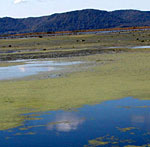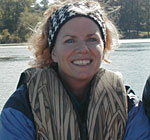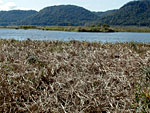By Erin Galbally
Minnesota Public Radio
September 26, 2002
For years there has been controversy over the way the Army Corps of Engineers controls the water levels in the Mississippi River. Some people say the levels are determined based on commerce as opposed to the good of the river. Now an experiment to reduce water levels in a 23 mile area near LaCrosse has local residents excited. They say their stretch of the river has turned into a prime habitat for fish and water fowl. The project results have been so impressive, the draw down method is expected to be used in other areas along the Upper Mississippi as soon as next year.
| |
|
|
|
||
The idea is very simple. For two weeks in the beginning of the summer, dam operators release a little extra water every day. Eventually, water levels decrease by 18 inches which is just enough to expose swaths of what had been riverbed to the open air and sun. Ultimately, what's known as the drawdown gave a sleeping ecosystem a jump-start.
Now three short months later a diversity of plant and bird life has returned to Pool 8, a segment of the Upper Mississippi that spans the bluff land region from Dresbach down to Genoa, Wisc.
Gretchen Benjamin, works as the Mississippi River Planner for the Wisconsin Department of Natural Resources, says this is the second consecutive year the pool's water level has been lowered.
On a recent trip, Benjamin kills her boat motor in a back channel of the Mississippi. She says this year's results are more exiting than ever. Then she leans over the side of the boat and points.
| |
|
|
|
||
"If you look into the water you'll see the plants family well that are growing in the water and those are submersed plants and those plants do real well," Benjamin explains.
The plants wave in the current, but remain firmly rooted the river floor. Thanks to the restoration of islands around the back channels, the Mississippi isn't as fast moving here as it is in the main channel. That allows underwater plants to flourish. It also provides ideal conditions for other native plant populations to grow, like the ones that surround various back channel islands. Those plants provide a barrier against runoff, and help keep the land mass intact.
Benjamin steers the boat out towards the main channel.
| |
|
|
|
||
"I wouldn't say we've seen any new species," says Benjamin. "It's just the abundance and we have diversity from the standpoint that with in one bed there might be several different kinds of species as compared to before when there was just one kind of plant there."
Dam operators stopped letting water out weeks ago. And now as fall arrives the river level has returned to where it was before the drawdown. The change in season means vegetation is dying back, but the positive impact is still visible.
"This is not as spectacular as it was a month ago. These plants were three or four feet tall and this was just a sand bar a year ago, no excuse me two years ago," Benjamin says.
An island close to the center of the main channel is surrounded by fading plants. Benjamin's both surprised and pleased they've have flourished here, so close the river's transportation corridor.
| |
|
|
|
||
"They're arrowhead," Benjamin says, gesturing towards the stalks. "They're a favorite food of the tundra swans that migrate through here so there all going to be feeding here and they're perennial plants so they'll be feeding here year after year."
The swans should be arriving around the beginning of October. Meanwhile schools of ducks are abundant and great beaked pelicans rest close to the shore. The draw down worked as a collaboration between multiple state and federal agencies. That includes the Army Corps of Engineers, the U.S. Fish and Wildlife Service and state agencies from both Wisconsin and Minnesota.
Given the success of the Pool 8 project, Benjamin says next year another pool along Upper Mississippi will undergo similar treatment. Meanwhile biologists will continue to monitor the plant and animal life along Pool 8.




